
Aisanyesvara Siva Temple is a 13th-century Hindu temple dedicated to Shiva located in Bhubaneswar, the capital of Odisha, India. The temple is in the precinct of Municipal Corporation Hospital, Sriram Nagar, Old Town, Bhubaneswar. It is close to the western compound wall of Lingaraj Temple. This is a living temple and with a shrine facing east.

Jalesvara Siva Temple Precinct is a Hindu Temple dedicated to Shiva situated on the southern outskirt of the village Kalarahanga at a distance of 2.00 km from Patia and 6.00 km south of Chudangagada in the northern outskirt of Bhubaneswar, Odisha, India. The presiding deity is a Siva-lingam within a circular yonipitha inside the sanctum, which is 1.15 meters below the chandrasila. The sanctum measures 2.00 square meters.
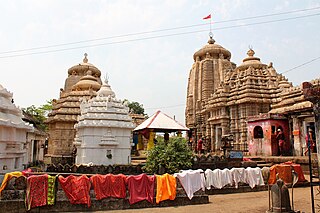
The Kapilesvara temple is a Hindu temple dedicated to Shiva located in the south western outskirt of the village Kapilesvara, Old Town, Bhubaneswar, Odisha, India. It is located at the end of Kapilesvara road leading from Lingaraj temple to Kapilesvara Village. The presiding deity is a Siva-lingam at the center of a circular yonipitha inside the sanctum. It is a living temple, facing towards east and maintained by Kapilesvara Temple Trust Board. The temple is situated within the precinct along with 33 other monuments. The precinct is located on the northern embankment of Manikarnika tank over an area of 44.00 square metres.

Lokanatha Siva Temple also Amunha Deula is an 11th-century AD temple in Bhubaneswar in the state of Odisha, India. It represents a proto type of Lingaraja in a miniature form. Lokanatha Siva temple is located in front of the Lingaraja temple in the south eastern corner across the road and adjacent to Lingaraja Temple Police Station in Old Town, Bhubaneswar. Until 1972 the temple was buried from all sides up to the bandhana portion, giving an impression as if the temple had no entrance. Hence people called it Amuha deula. In 1972 Debala Mitra conducted an excavation in front of the northern wall and exposed the entrance. The sanctum was empty. However, on the basis of the local traditions and the sculptural embellishment on the outer wall it was ascribed to Lord Siva. It is now known both as Lokanatha Siva and Amuha deula. People ascribe the temple to the Kesharis (Somavamsis). Except the entrance all other sides it is buried up to the bandhana.

Chintamaniswar Shiva Temple is a Hindu temple dedicated to Lord Shiva in Bhubaneswar, the capital of Odisha, India. It is at the end of the Chintamaniswar road branching from Cuttack-Puri road near the Old Station Bazar. The temple faces west and the enshrined deity is a Siva lingam with a yonipitha.
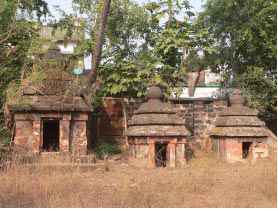
Sankarananda Matha is located in Uttaradaraja Badu Sahi, on the southern embankment of Bindusagar tank in Old Town, Bhubaneswar. It is situated in the left side of the Sankarananda Street branching from the Ratha road. This is a most dilapidated monastery. It is a branch of Sankarananda Matha at Puri. Sankara Sivananda Saraswati was the founder of the matha. Some of the previous matha mahantas are Sachidananda Saraswati, Balabrahmanda Saraswati, and Ramakrishnananda Saraswati. It has got multiple ownership. The Matha is under the control of Endowment Department but it is in a bad state of preservation. Balabrahmanda Saraswati is the present mahanta of the Matha. Only a shrine is in use and under worship.

Suresvara Mahadeva temple, also known as Byamokesvara temple, is located in the Tala bazaar market complex, Old Town of Bhubaneswar, the capital of the state of Orissa,India. The temple is located in front of the Lingaraj Temple across the road in the left side of the eastern gateway at a distance of 10.00 m. The temple faces towards the west. It is a living temple and the enshrined deity is a Siva lingam with a circular yonipitha at the centre of the sanctum. At present the sanctum is 1.50 m below the present road level. It is a recently recovered temple that had been buried. It was built in 10th century AD. The temple is maintained by the local shopkeepers.

Beleswara Shiva Temple is a 9th-century Hindu temple of Lord Shiva. This is one of the oldest temple in Bhubaneswar, a well known heritage place and capital of Odisha. The festivals of this temple's are Shivratri and all Sankrantis.

Bharati Matha Temple is a temple of the Hindu God Siva in Bhubaneswar, Orissa, India, The temple is a Hindu monastery with three stories which was built in the 11th century AD. It is currently used for living Matha purposes and earlier it was used as a Hindu pilgrimage centre.

Vishnu Temple is located within the Kapilesvara Temple precinct Kapilesvara village, Old Town, Bhubaneswar. It was built in the 15th century AD. The temple is facing towards east and the presiding deities of this temple are two Vishnu images, and the image of Jagannatha, Balabhadra, Subhadra and Buddha. The sanctum measures 2.10 square m. The temple is made of laterite stone. It is under the care of the Kapilesvara Temple Trust Board.

The Somesvara Siva temple is located in the Kharakhia Baidyanath temple precinct in Kharakhia Vaidyanath Sahi, Old Town, of Bhubaneswar. It is located approximately 300 metres south of Lingaraja temple. Visitors may approach the site on the left side of Baidyanath Road leading from Lingaraja temple to Kapilesvar. It is a living temple and faces towards the west. The enshrined deity of this temple is a Siva lingam within a circular yonipitha at the center of the sanctuary located 0.93 metres below the chandrasila. The temple is under the care and maintenance of Babulal Makaddam Badu Mohapatra, the chief priest of the temple, on whose private land the temple stands.

Patalesvara Siva Temple – III is a Siva temple located on the Mandir Chowk of Old Town, Bhubaneswar, Orissa, India. The temple dates to the 13th century AD.
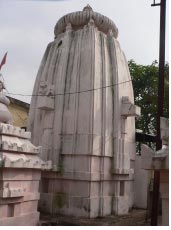
Isanesvara Siva Temple is a 13th-century ad temple in Bhubaneswar in the state of Orissa, India. The time period of its construction is estimated from its architectural features and it is suggests the temple to ganga period. Isanesvara Siva temple is in the Goasagaresvartemple precinct, on the left side of Ratha road old Town, Bhubaneswar. It is one kilometre (0.62 mi) west of Lingaraja Temple and one km south of Ananta Vasudev, 300 m (980 ft) southwest of Ramesvara temple and 200 m (660 ft) northwest of Baitala Deula. The temple is facing towards east. The presiding deity is only a circular yon pitha. The lingam is missing.
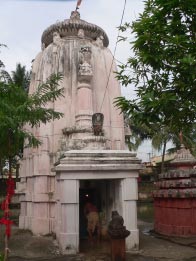
Paradaresvara Siva Temple is a 13th-century AD temple in Bhubaneswar, Odisha. The time period of its construction is estimated from its architectural features and it suggests that the temple must belong to the ganga period. Paradaresvra Siva temple is situated in the Gosagaresvar temple precinct. It is located on the left side of Ratha road old town, Bhubaneswar. It is located at a distance of 1 km west of Lingaraja Temple and 1 km south of Ananta Vasudev, 300 metres southwest of Ramesvara Temple and 200 metres northwest of Vaital Temple. The temple is facing towards east. The presiding deity is only a circular yonipitha in the cella that measures 3 square metres. The lingam is missing.

Ladu Baba Temple is a temple in Bhubaneswar, Odisha, India. It was built in the 13th century AD and was formerly known as Kainchhi Temple.

Lakhesvara Siva temple Location: Lat 20° 14’ 33"N, Long 85° 50’ 17" E, Elev 60 ft. Approach- Lakhesvara Siva temple is located in the right side of the Ganges–Yamuna road, behind the Lingaraja market complex, Old town, Bhubaneswar,Orissa,India. It is situated at a distance of 70 metres north east of Lingaraj temple and at a distance of 10 metres south of Gangesvara and Yamunesvara Siva temple across the road. The temple is facing towards the east. The enshrining deity is a Siva lingam within a circular yoni-pitha, which is 0.77 metres below the chandrasila.

Uttaresvara Siva Temple is a 12th-century Hindu temple dedicated to Lord Siva located in Bhubaneswar, Odisha, India.

Lingaraja Rest House/ Lingaraja Bisrama Ghara
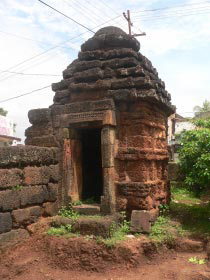
Papanasini Siva Temple is an abandoned Hindu temple located in Bhubaneswar, Orissa, India.

Sinduresvara Siva temple is located in village Sundarpada, Old Town, Bhubaneswar, Odisha, India. It is on the right side of the road leading from Lingaraj temple to Sundarpada. The enshrined deity is a circular yonipitha facing towards the north. The Siva lingam decayed in course of time. In April 2013 the villagers raised funds and reestablished new Shiv Linga. There are two entrances on the south-west and northwest corners provided with seven flights of steps leading down to the temple.









